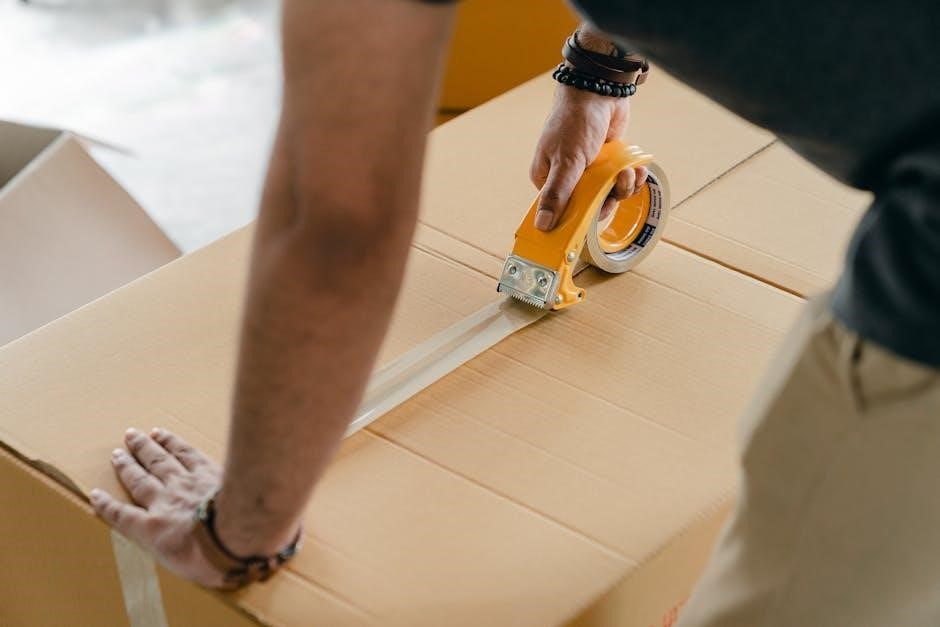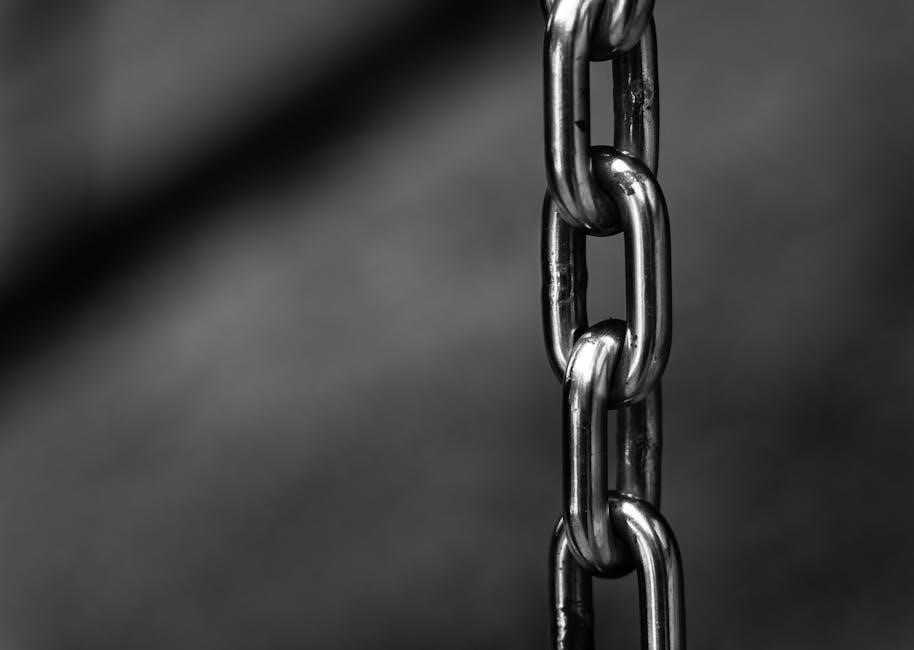Link-Seal charts are essential tools for proper sizing and installation of modular seals in various pipe applications, ensuring a watertight fit and long-term durability.
These charts provide standardized methods to determine the correct Link-Seal model, sleeve length, and hardware, optimizing performance for water, underground, and industrial environments.
Overview of Link-Seal Modular Seals
Link-Seal modular seals are durable, pre-fabricated elastomer sealing elements designed to provide a watertight seal around conduits in concrete walls, floors, and casings. They are quick to install, saving up to 75% of the time compared to traditional methods. Made from materials like EPDM, nitrile, and silicone, these seals resist aging, ozone, sunlight, water, and various chemicals. They are suitable for water, underground, and atmospheric applications, offering long-term reliability. Available in multiple models, Link-Seal modular seals ensure a permanent and efficient sealing solution for diverse industrial needs.
Importance of Sizing Charts in Link-Seal Applications
Sizing charts are crucial for ensuring accurate and efficient installation of Link-Seal modular seals. They provide detailed guidance to determine the correct seal size based on pipe type, outside diameter, and wall opening. Proper sizing prevents leaks, ensures durability, and optimizes performance. Incorrect sizing can lead to sealing failures or premature wear. By referencing these charts, users can quickly identify the appropriate model, sleeve length, and hardware, ensuring a watertight seal tailored to specific environmental conditions. This step is essential for achieving long-term reliability and performance in various applications.

Key Features and Benefits of Link-Seal Modular Seals
Link-Seal modular seals offer time and cost efficiency, saving up to 75% on installation time. Made from durable elastomers like EPDM, Nitrile, and Silicone, they ensure long-lasting resistance to environmental factors. Their modular design provides versatility for various pipe sizes and types, delivering reliable sealing in water, underground, and atmospheric conditions.
Time and Cost Efficiency
Link-Seal modular seals install up to 75% faster than traditional methods, significantly reducing labor costs. Their modular design allows for quick adjustments, minimizing downtime. With no need for specialized tools, installation is straightforward, saving time and resources. This efficiency makes them a cost-effective solution for sealing applications across various industries, ensuring a quick return on investment while maintaining high performance standards.
Material Durability and Resistance
Link-Seal modular seals are crafted from high-performance elastomers such as EPDM, Nitrile, and Silicone, ensuring exceptional resistance to aging, ozone, sunlight, and chemicals. Their durable construction withstands harsh environmental conditions, making them ideal for water, underground, and industrial applications. The seals’ resistance to hydrostatic pressure and wide range of chemicals ensures long-lasting performance, reducing the need for frequent replacements and maintaining a secure seal over time.
Versatility in Applications
Link-Seal modular seals are highly versatile, suitable for a wide range of applications including water and wastewater systems, direct ground burial, and atmospheric environments. Their adaptability allows them to be used in various pipe types and sizes, ensuring reliable performance across different industries. The modular design enables easy customization to meet specific project requirements, making them a practical solution for diverse sealing needs. This versatility contributes to their popularity in both standard and specialized applications, ensuring a secure and durable seal in any setting.

How to Use Link-Seal Sizing Charts
Determine the correct Link-Seal model by locating the appropriate chart for your pipe type and verifying the pipe’s outside diameter for accurate sizing.
Step-by-Step Guide to Determining the Correct Seal Size
To determine the correct Link-Seal size, start by identifying the pipe type and its outside diameter using the provided charts. Next, locate the corresponding chart for your pipe type and size. Verify the pipe’s O.D. matches the chart’s specifications to ensure accuracy. Then, select the appropriate Link-Seal model based on the sizing data. Finally, confirm the wall opening type and hardware requirements to complete the selection process, ensuring a precise and reliable seal installation.
Locating the Appropriate Chart for Your Pipe Type
To locate the correct chart, identify your pipe type (e.g., standard, custom, or non-standard) and refer to the corresponding section in the Link-Seal PDF guide.
Next, match your pipe’s specific size and type with the chart’s specifications to ensure accurate sizing.
For standard pipes, charts are categorized by pipe size and material, while custom pipes may require additional calculations or consultations.
Always verify the chart’s relevance to your application to avoid errors in seal selection.
If unsure, consult the guide’s index or contact the factory for assistance.
This step ensures proper fitment and performance of the Link-Seal modular seal.
Verifying Pipe Outside Diameter (O.D.)
Accurate measurement of the pipe’s outside diameter (O.D.) is crucial for correct Link-Seal modular seal sizing.
Use a precision caliper or tape measure to determine the O.D., ensuring it matches the specifications in the Link-Seal chart.
Refer to the chart’s O.D. range for your pipe type and size to confirm compatibility.
If the measured O.D. does not align with the chart, consult additional resources or contact the factory for guidance.
This verification step ensures a proper fit and optimal sealing performance.
Precision in this process is key to achieving a watertight and durable seal.

Installation and Configuration
Proper installation ensures a watertight seal around conduits in concrete walls and floors using Century-Line sleeves, steel sleeves, or Cast/Core bit drilled holes, saving up to 75% time compared to competitors.
Understanding Wall Opening Types (Model CS, WS, Cast/Core Bit Drilled)
Link-Seal modular seals are designed for various wall opening types, including Model CS for thin walls, WS for steel sleeves, and Cast/Core Bit Drilled holes. Each type ensures proper sealing in different environments, from direct burial to atmospheric conditions. Model CS is ideal for walls less than 8″ thick, while WS suits standard steel sleeves. Cast/Core Bit Drilled openings provide precise fits for custom applications. Understanding these types is crucial for selecting the right seal model, ensuring optimal performance and durability in water, wastewater, and industrial settings.
Matching Performance Characteristics with Service Conditions
Link-Seal modular seals must be matched to service conditions for optimal performance. Elastomers like EPDM, Nitrile, and Silicone offer resistance to chemicals, ozone, and UV exposure. Tensile strength and ASTM specifications ensure durability in water, wastewater, and industrial environments. Proper sizing and material selection, guided by sizing charts, ensure seals withstand hydrostatic pressure and environmental stresses, providing long-term reliability and integrity in various applications.
Sealing Elements and Hardware Options
Link-Seal modular systems offer interchangeable sealing elements made from durable elastomers, ensuring compatibility with various service conditions. Hardware options include stainless steel or zinc-plated components, providing corrosion resistance. The modular design allows for easy replacement of worn elements, extending the seal’s lifespan. These configurations, detailed in the sizing charts, ensure a customized fit for specific pipe sizes and wall openings, enhancing performance and reliability in demanding environments.

Link-Seal Sizing Charts for Standard Pipe
These charts provide comprehensive size guides for standard pipes, ensuring accurate Link-Seal model selection based on pipe O.D. and wall opening types.
Pipe Size Charts and Corresponding Link-Seal Models
These charts offer detailed correlations between standard pipe sizes and appropriate Link-Seal models, ensuring precise selections based on pipe outside diameter and wall opening configurations.
Annular Space Calculation for Proper Sizing
Accurate annular space calculation is crucial for correct Link-Seal sizing, ensuring optimal sealing performance. This involves measuring the difference between the pipe’s outside diameter and the wall opening, then referencing sizing charts to select the appropriate model. Proper calculations prevent gaps, ensuring a watertight seal and long-term durability in various applications, including water, wastewater, and underground installations.
Example: SDR-35 Gravity Sewer Pipe Sizing
For SDR-35 gravity sewer pipes, sizing charts provide a quick reference to select the correct Link-Seal model. By matching the pipe’s outside diameter to the chart, users can determine the appropriate seal size, ensuring a precise fit and preventing leaks. This method streamlines the sizing process, offering an efficient and cost-effective solution for underground applications, while maintaining the structural integrity and sealing performance required for gravity sewer systems.

Custom and Non-Standard Pipe Solutions
Custom solutions are available for pipes not listed in standard charts, ensuring proper sealing. Contact the factory for special requirements and CS model sleeves for thin walls.
Handling Pipe Sizes Not Listed in the Charts
For pipe sizes not listed in the charts, custom solutions are available. Contact the factory to discuss specific requirements and ensure proper sealing. Provide detailed pipe specifications, including O.D. and wall thickness, to determine the appropriate Link-Seal model and sleeve length. This ensures a tailored fit for non-standard applications. Factory experts can also recommend alternative configurations or materials to meet unique demands. Accurate measurements are crucial for custom orders to guarantee optimal performance and durability in challenging environments. This approach ensures reliability even for unconventional pipe sizes.
CS Model Plastic Sleeves for Thin Walls
CS Model plastic sleeves are designed for thin-wall applications, offering a reliable sealing solution where standard sleeves may not fit. Made from durable plastic, these sleeves provide a secure, watertight seal in walls thinner than 8 inches. They are lightweight, easy to install, and ideal for tight spaces. The CS Model is a cost-effective alternative for challenging wall conditions, ensuring long-term performance without compromising on quality. For detailed specifications, refer to the Link-Seal PDF guide or contact the factory for custom solutions tailored to your needs.
For pipe sizes not listed in standard charts or unique application needs, contacting the factory is essential. Provide details such as pipe size, wall type, and specific requirements to ensure custom solutions. The factory offers technical support to design tailored Link-Seal models, including CS Model plastic sleeves for thin walls. This service ensures optimal performance and compatibility, addressing special conditions not covered by standard sizing charts. Reach out for custom orders or modifications to meet your project’s specific demands, guaranteeing accurate and reliable sealing solutions.

Materials and Performance Characteristics
Contacting the Factory for Special Requirements
For pipe sizes not listed in standard charts or unique application needs, contacting the factory is essential. Provide details such as pipe size, wall type, and specific requirements to ensure custom solutions. The factory offers technical support to design tailored Link-Seal models, including CS Model plastic sleeves for thin walls. This service ensures optimal performance and compatibility, addressing special conditions not covered by standard sizing charts. Reach out for custom orders or modifications to meet your project’s specific demands, guaranteeing accurate and reliable sealing solutions.
Elastomers Used (EPDM, Nitrile, Silicone)
Link-Seal modular seals utilize high-performance elastomers like EPDM, Nitrile, and Silicone, each offering unique properties. EPDM excels in ozone and UV resistance, ideal for outdoor and underground applications. Nitrile provides superior resistance to oils and hydrocarbons, making it suitable for industrial environments. Silicone, known for its flexibility and temperature resistance, is used in extreme conditions. These materials ensure the seals remain durable and resistant to environmental factors, providing long-lasting performance across various industries. Their specific characteristics are matched to service conditions to optimize sealing efficiency and durability.
Chemical and Environmental Resistance
Link-Seal modular seals are engineered to withstand harsh chemical and environmental conditions, ensuring reliable performance in diverse applications. Their elastomers are formulated to resist aging, ozone, sunlight, and a wide range of chemicals, making them ideal for water, wastewater, and underground installations. The seals maintain integrity in direct ground burial and atmospheric exposures, providing a durable barrier against environmental stressors. This resistance is critical for maintaining hydrostatic sealing and preventing degradation over time, ensuring long-term reliability in demanding service conditions.
Tensile Strength and ASTM Specifications
Link-Seal modular seals meet stringent ASTM specifications, with a tensile strength of 85,000 psi, ensuring exceptional durability and reliability in demanding environments. Constructed from high-quality materials, including ANSI Type 316 stainless steel, these seals are engineered to withstand rigorous service conditions. Compliance with ASTM F593-95 standards guarantees consistent performance, making them suitable for water, wastewater, and underground applications where strength and longevity are critical. This adherence to industry standards ensures the seals maintain integrity and provide reliable sealing solutions over time.

Applications of Link-Seal Modular Seals
Link-Seal modular seals are widely used in water and wastewater systems, direct ground burial, and atmospheric conditions, ensuring reliable sealing in diverse industrial and environmental applications.
They are ideal for underground installations, chemical-resistant environments, and scenarios requiring durable, long-lasting sealing solutions to prevent leakage and maintain structural integrity in critical infrastructure.
Water and Wastewater Applications
Link-Seal modular seals excel in water and wastewater systems, providing reliable sealing solutions for pipes in treatment plants, distribution networks, and sewerage infrastructure.
Their resistance to chemicals, UV, and ozone ensures durability in harsh environments, while their hydrostatic sealing capabilities maintain integrity under pressure, making them ideal for submerged and buried pipe systems.
Direct Ground Burial and Underground Use
Link-Seal modular seals are specifically designed for direct ground burial and underground applications, offering superior protection against soil and moisture penetration.
Constructed with durable elastomers like EPDM, Nitrile, and Silicone, these seals resist environmental degradation, ensuring long-lasting integrity in buried environments.
Their ability to maintain a watertight seal, even under earth pressure, makes them ideal for underground infrastructure, preventing corrosion and extending the lifespan of buried pipes and conduits.
Atmospheric and Industrial Environments
Link-Seal modular seals excel in atmospheric and industrial settings, providing reliable sealing solutions for pipes exposed to air, humidity, and chemicals.
Their elastomers, such as EPDM and Silicone, are formulated to withstand ozone, UV light, and various chemical agents, ensuring durability in harsh conditions.
These seals are ideal for industrial plants, outdoor installations, and corrosive environments, maintaining their integrity and preventing leaks effectively.

Troubleshooting and Maintenance
Link-Seal modular seals are designed to prevent leaks and ensure longevity, with easy inspection and replacement options for worn-out elements, maintaining optimal performance.
Common Issues and Solutions
Common issues with Link-Seal modular seals include improper sizing, insufficient sleeve length, or material incompatibility. Solutions involve using sizing charts to ensure accurate fit, consulting the engineering manual for technical guidance, and selecting appropriate elastomers for environmental conditions. Regular inspections and timely replacement of worn seals prevent leaks and maintain performance. Proper installation and alignment are critical to avoid damage and ensure long-term durability. Always refer to the manufacturer’s guidelines for troubleshooting and maintenance procedures.
Ensuring Proper Hydrostatic Sealing
Ensuring proper hydrostatic sealing with Link-Seal modular seals requires precise sizing using provided charts, correct sleeve length, and appropriate elastomer selection. Proper installation ensures a watertight fit, resisting hydrostatic pressure. Regular inspections and timely replacements of worn seals maintain integrity. Aligning performance characteristics with service conditions and using compatible hardware enhances sealing efficiency. Always follow manufacturer guidelines for installation and maintenance to achieve optimal hydrostatic sealing performance in water, underground, and industrial applications.
Inspecting and Replacing Worn Seals
Regular inspection of Link-Seal modular seals is crucial to ensure optimal performance. Look for signs of wear, cracks, or leaks, which indicate the need for replacement. Replace worn seals promptly to maintain hydrostatic sealing and prevent system compromise. Use the sizing charts to select the correct replacement model, ensuring compatibility with your pipe type and application. Always follow the manufacturer’s guidelines for inspection and replacement procedures to guarantee long-term durability and reliability in water, underground, and industrial environments.

How to Order Link-Seal Modular Seals
Use sizing charts to determine the correct model, sleeve length, and hardware. Reference pipe O.D., wall opening type, and service conditions for accurate ordering, ensuring compatibility and performance.
Using the Sizing Charts for Accurate Ordering
To ensure precise ordering, use Link-Seal sizing charts to match pipe type, size, and wall opening. Locate the chart corresponding to your pipe specifications, verify the outside diameter, and identify the appropriate Link-Seal model. Consider annular space and sealing elements. Reference charts for standard or custom solutions, ensuring compatibility with service conditions. Proper sizing guarantees optimal performance and longevity, avoiding costly rework. Always cross-check measurements and requirements before finalizing your order for modular seals.
Specify Sleeve Length and Model Requirements
Accurately specify sleeve length and Link-Seal model by referencing sizing charts. Measure the wall opening type (CS, WS, or drilled) and calculate annular space for proper fit. Choose elastomers like EPDM, Nitrile, or Silicone based on environmental conditions. Ensure hardware options match service demands. Sleeve length should cover the entire wall opening, with adequate material for a secure seal. Proper specifications ensure optimal performance, longevity, and resistance to chemicals or environmental stressors, minimizing future maintenance needs.
Downloading and Referencing the PDF Guide
Download the official Link-Seal PDF guide from the manufacturer’s website for detailed sizing charts and technical specifications. This comprehensive resource includes standard pipe size charts, annular space calculations, and model recommendations. The guide also provides step-by-step instructions for selecting the correct modular seal and hardware. Updated regularly, it ensures accurate ordering and installation; Referencing the PDF is essential for matching performance characteristics with service conditions, ensuring a proper seal and optimal durability in water, underground, and industrial applications.
